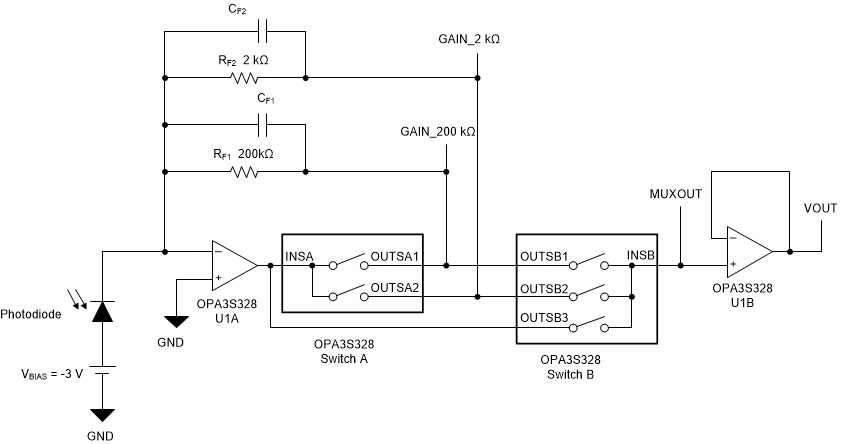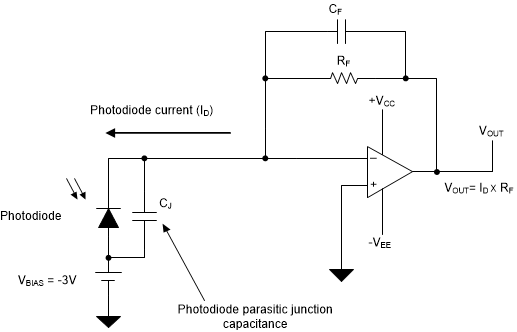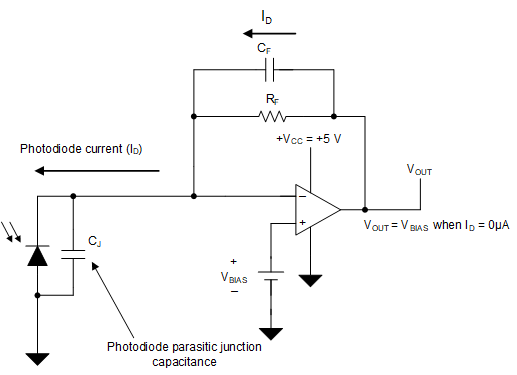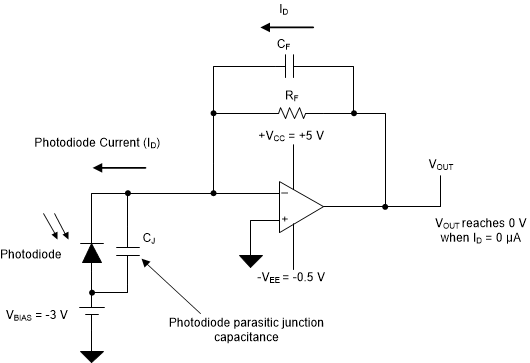-
Build a Programmable Gain Transimpedance Amplifier Using the OPA3S328
Build a Programmable Gain Transimpedance Amplifier Using the OPA3S328
Trademarks
All trademarks are the property of their respective owners.
1 Introduction
Photodiode sensors produce a current output that changes with incident light, where the typical photocurrent changes orders of magnitude from hundreds of pico-amps to a few milliamps. Transimpedance amplifiers are essential circuits in photodiode acquisition systems to convert photocurrent to voltage that will drive a typical Analog-to-Digital (ADC) converter.
TIAs are required to amplify a photodiode's signal while meeting low-noise, high-resolution, and high-bandwidth constraints. A programmable gain TIA stage allows flexibility to measure the wide range of photodiode current while ensuring the amplifier remains inside its linear range. Programmable gain TIAs are essential in many systems. Applications include photosensor devices such as chemical analysis systems, infrared spectroscopes, data acquisition systems and optical communication applications where the optical power in a fiber can vary widely, and, as a result yield wide current ranges from an optical detector.
The OPA3S328 is a dual precision CMOS operational amplifier (op-amp) with integrated switches optimized for programmable gain transimpedance amplifier applications. The dual op-amp offers low input bias current, DC precision performance, low noise, high bandwidth, providing an optimal choice for transimpedance amplifier applications.
The simplified circuit diagram shown in Figure 1-1 shows a programmable gain TIA circuit implemented with the OPA3S328. The OPA3S328 integrates analog switches useful to select the TIA gains across multiple decades of photodiode current. The second-stage amplifier buffers the programmable gain TIA stage using Kelvin sense connections to eliminate errors due to the switch on-resistance, switch resistance drift, and non-linearity. This document provides a step-by-step example for designing a low noise, high bandwidth, high accuracy programmable TIA to perform optical power measurements using a near infrared (NIR) wavelength photodiode.
 Figure 1-1 Switched Gain Transimpedance Amplifier
Figure 1-1 Switched Gain Transimpedance Amplifier2 The Transimpedance Amplifier and Photodiode Sensor
A transimpedance amplifier consists of an op amp and a feedback resistor. The photosensor current to be amplified is applied to the inverting input, causing the output voltage of the amplifier to change, as shown in Figure 2-1:
 Figure 2-1 Photodiode Transimpedance Amplifier
Figure 2-1 Photodiode Transimpedance AmplifierThe feedback resistor (RF) across the op amp converts the photodiode current (ID) to a voltage (VOUT) using Ohm’s law, as shown in Equation 12.

The feedback resistor (RF) determines the gain of the transimpedance op-amp. For the transimpedance current to voltage conversion to be accurate, the amplifier’s input bias current and input offset voltage must be small. The OPA3S328 offers low offset voltage, 25µV (max) and low input bias current, 0.2 pA. The photodiode parasitic junction capacitance plays a significant role in the stability and bandwidth of the TIA circuit, as we will discuss in detail in the following sections. The feedback capacitor (CF) is required to compensate the circuit for stability.
This example shows a large area near-infrared (NIR) wavelength Indium Gallium Arsenide (InGaAs) photodiode for the design. In this specific application, the photodiode operates on the photoconductive mode, where exposure to light causes a reverse current through the detector. A reverse bias is applied to the photosensor to reduce the junction capacitance. The reverse bias voltage (VR) dramatically improves the speed of response and linearity of the photodiode. The reverse bias increases the depletion region width and consequently decreases the junction capacitance. The dark current of this photosensor is about 50nA in this mode of operation. Table 2-1 shows the photodiode parameters.
| Parameter | Symbol | Value | Unit |
|---|---|---|---|
| Reverse Voltage | VR | -3 | V |
| Junction Capacitance (VR=-3V) | CJ | 100 | pF |
| Reverse Current Range | ID | 0-2000 | µA |
| Dark Current | Idark | 50 | nA |
There are different ways to bias the photodiode in the TIA circuit. A common method used on unipolar supply applications is to bias the op-amp non-inverting input (+IN) with a positive dc voltage. The positive voltage at the non-inverting input will reverse bias the photodiode while allowing the amplifier output to reach true zero when the photodiode is unexposed to light and respond without the added delay that results from coming out of the negative rail. Figure 2-2 shows a typical way to reverse bias the photodiode, when the reverse voltage required is relatively small.
 Figure 2-2 Unipolar-Supply Transimpedance Amplifier
Figure 2-2 Unipolar-Supply Transimpedance AmplifierHowever, in this example, the diode requires a relatively large reverse bias voltage of -3V when compared to the 5.5V maximum voltage supply range of the OPA3S328. A different method to reverse bias the diode is to apply the negative bias voltage (VR = -3V) directly to the photodiode's anode. This configuration is shown in Figure 2-3.
 Figure 2-3 Bipolar-Supply Transimpedance Amplifier
Figure 2-3 Bipolar-Supply Transimpedance AmplifierThe non-inverting OPA3S328 terminal connects to ground and the amplifier is powered with bipolar asymmetrical supplies, Vcc = +5 V and Vee = -0.5 V, allowing the dc voltage output to reach true zero when the diode is not exposed to light. In addition, this circuit makes better use of the OPA3S328 output voltage range, allowing a large diode reverse bias voltage without impacting the voltage range of the output signal.